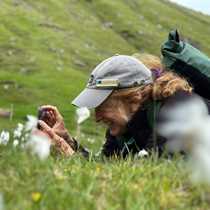Isla Magdalena and Hull Canal
The beach of Isla Magdalena wore a necklace of red jewels this morning. As we landed, we found that the jewels had pinchers. Hundreds of thousands of pelagic red crabs had been washed ashore by a combination of high tides and strong winds. In the space of a rectangle made by connecting both index fingers and thumbs into an “L” shape, twenty-two individual crabs were counted. Multiply that by a two-foot margin skirting the beach and then extend that swath for a couple of miles. There were millions. It was not wasted on the scores of birds lining the shore. Amongst them western gulls gorged themselves on the opportunistic feast. The gulls had been working on this bounty for a while, as was evidenced by the splotches of guano splatted across the beach; the solid parts were red.
The destination for our walks was the Pacific side of this barrier island. Up, down, over and between the dunes we explored, finding numerous tracks including coyote, jackrabbit, mice, birds and the zippered tracks of small black beetles. When we reached the Pacific side we found mounds of sand dollars. Marooned in the sand they had bleached to a crisp linen-white. Some folks had gathered piles of them; we decided the collective noun for a pile of sand dollars was a “treasury.” It seemed to fit.
The winds were stronger here and the fine floury sand danced across the harder packed beach. The constant motion of the suspended sand skittering over the darker wet beach gave an illusion of party streamers undulating at our feet. In small swales between the dunes we found many shell middens. Amongst the broken shells of one midden the wind had revealed four very special prizes: stones. These were not arbitrary stones on the landscape. They were the only stones in this landscape. Left by pre-Hispanic era inhabitants, these lonely rocks are believed to be tools formerly used to break into the thick shells of the murex snails and other sea creatures. For today, they were exposed and admired as a rare glimpse into a lost culture and people; tomorrow they may be re-buried by the constantly shifting sands and landscape. The skies darkened, the winds increased, clouds threatened rain, but it too blew away and we ended our walks in sunshine.
Hull Canal is our passageway north, towards the town of Lopez Mateos and the birthing grounds and nurseries of California gray whales. Just before turning the corner of Colina Coyote we sighted our first blows. The winds quickly knocked the thin wisps down, but they were unmistakable and soon we slowed to a crawl and navigated through a slalom course of gray whale cows and their newly born calves. An auspicious ending for a day filled with treasures, and at the same time, holding great promise for tomorrow.




